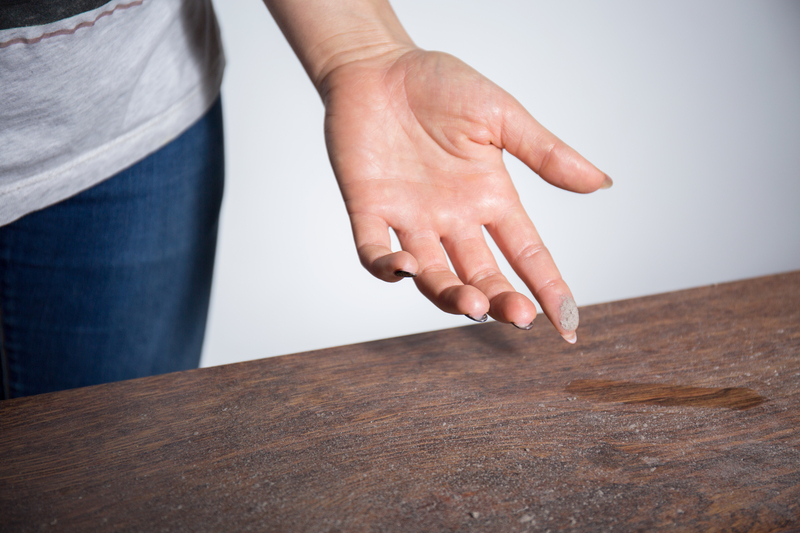The Art of Maintaining a Clean and Allergy-Free Home
Posted on 20/06/2025
The Art of Maintaining a Clean and Allergy-Free Home
Maintaining a spotless and allergy-free home is more than just about aesthetics; it's about ensuring the health and well-being of every family member. With numerous allergens lurking in the nooks and crannies of your living space, adopting specialized cleaning methods becomes vital. Whether you have pets, children, or simply value hygienic surroundings, creating a home environment that's free from dust, mold, pollen, and other common allergens is attainable with the right strategies.
Why Is It Important to Keep Your Home Allergy-Free?
Allergens such as pet dander, dust mites, mold spores, and pollen can easily accumulate indoors, triggering allergic reactions and respiratory issues. For people with asthma, allergies, or compromised immune systems, a clean environment isn't just desirable--it's essential.
- Improved indoor air quality reduces respiratory risks.
- Less exposure to irritants enhances sleep quality and comfort.
- Lower incidence of asthma attacks and allergic reactions, especially in children.
- Better overall mood and well-being, as clutter and dust can impact mental health.
Maintaining a clean and allergy-free home requires consistency, awareness, and a tailored approach to household cleaning. Let's explore comprehensive methods and best practices to transform your home into a haven of cleanliness and health.

Common Sources of Indoor Allergens
Identifying the predominant sources of allergens is the first step towards effective cleaning. The most frequent culprits include:
- Dust mites: Microscopic bugs thriving in bedding, mattresses, and upholstered furniture.
- Pet dander: Tiny flakes of skin shed by cats, dogs, and other furry pets.
- Mold spores: Fungus that grows in damp areas such as bathrooms, kitchens, and basements.
- Pollen: Fine seasonal particles that can be carried indoors through windows, doors, and on clothing.
- Cockroach droppings: Pest droppings that trigger strong allergic responses, especially in urban environments.
Understanding these sources not only helps target your cleaning efforts but also prevents future allergen build-up.
Step-by-Step Guide to Maintaining a Clean and Allergy-Free Home
1. Establish a Cleaning Schedule
Consistency is the cornerstone of allergy-free living spaces. Set up a weekly and monthly cleaning plan to ensure no area is neglected for too long.
- Weekly: Dust surfaces, vacuum carpets and rugs, wash bedding, mop floors, and clean bathrooms and kitchens.
- Monthly: Deep clean upholstery, launder curtains, clean windowsills, and wipe down baseboards and vents.
Assigning specific days for tasks helps break down cleaning into manageable parts, making it less overwhelming.
2. Proper Vacuuming Techniques
Vacuuming is central to both removing allergens and sustaining a spotless environment. For optimal results, invest in a vacuum cleaner with a HEPA (High-Efficiency Particulate Air) filter, which traps microscopic particles that standard vacuums may recirculate.
- Vacuum at least twice per week, especially in high-traffic zones.
- Don't forget upholstered furniture, drapes, and pet beds.
- Empty vacuum bags or bins regularly outside to prevent dust backflow indoors.
3. Tackle Dust Mites and Bedding Hygiene
Dust mites thrive in warm, humid environments--especially in bedding, mattresses, and pillowcases. To keep them at bay:
- Wash sheets, pillowcases, and comforters weekly in hot water (at least 130?F or 54?C).
- Use allergen-proof covers on mattresses and pillows to reduce exposure.
- Consider replacing pillows every two years.
Reducing dust mite populations is vital for anyone sensitive to airborne allergens.
4. Control Humidity and Prevent Mold Growth
Mold flourishes in damp spaces with poor air circulation. Keeping relative humidity between 30-50% can prevent fungal growth.
- Use dehumidifiers in basements and damp areas.
- Keep bathrooms and kitchens well-ventilated after use--crack a window or run exhaust fans.
- Fix leaks and promptly clean any signs of mold with a mixture of water and vinegar, or an anti-fungal cleaner.
5. Pet Care and Dander Management
While pets provide companionship, they are common sources of indoor allergens. Here's how to coexist with them:
- Bathe and groom pets regularly to minimize dander.
- Set boundaries--keep pets out of bedrooms and off furniture.
- Wash pet bedding weekly in hot water.
- Vacuum and dust pet-related areas thoroughly.
For severe allergies, consider air purifiers with HEPA filters in pet-frequented rooms.
6. Choose Allergy-Friendly Flooring and Furnishings
Carpets and heavy drapes trap dust, pollen, and dander. To create allergy-free living areas:
- Opt for hard flooring such as wood, tile, or vinyl--which are easier to keep clean.
- If carpets are necessary, select low-pile varieties and have them professionally cleaned annually.
- Choose washable curtains and avoid heavy, upholstered furniture when possible.
7. Improve Indoor Air Quality
Airborne particles are a persistent source of allergies. Incorporate the following strategies:
- Install high-quality air purifiers in main living areas and bedrooms.
- Replace HVAC filters every 3 months with HEPA-rated filters, or more frequently if allergies are severe.
- Avoid using air fresheners and scented candles, which can contain irritants.
- Open windows for ventilation during lows in outdoor pollen counts.
Additional Tips for an Ultra-Clean, Allergy-Proof Home
Declutter Regularly
Clutter collects dust and hampers cleaning efforts. Keep surfaces clear and store items in closed containers wherever possible.
Green Cleaning Products
Many household cleaning supplies contain chemicals that can worsen allergies. Opt for fragrance-free, non-toxic cleaning products or make your own with simple ingredients such as vinegar, lemon, and baking soda.
Keep Entryways Allergen-Free
Outdoor allergens like pollen and mold spores are often tracked indoors via shoes and outerwear:
- Establish a shoe-free policy indoors to prevent allergen transfer.
- Use doormats at all entrances, wash them regularly.
- Keep coats and bags stored away from living spaces.
Regular Maintenance of Appliances
Kitchen appliances and vents can harbor mold, dust, and grease over time. Clean refrigerator coils, exhaust fans, and filters to promote healthy air quality.
The Psychological and Physical Benefits of a Clean, Allergy-Free Home
A hygienic and allergen-free living space offers multifaceted advantages that go beyond the absence of sneezing and itching:
- Better sleep: Reduced irritants and a fresh environment support restorative rest.
- Improved concentration: Less exposure to mold and dust means fewer headaches or fogginess, boosting productivity.
- Enhanced immune function: A cleaner home reduces the microbial load, protecting against infections.
- Emotional well-being: Tidiness and order lay the foundation for a positive, uplifting atmosphere.
Special Considerations for Families with Allergy Sufferers
If you or your family members are particularly sensitive to allergens, it's critical to take extra measures:
- Have medication and emergency allergy action plans readily accessible.
- Consult an allergist to identify specific triggers and tailor your cleaning plan accordingly.
- Regularly monitor for mold growth in known problem areas, especially after storms or leaks.
Proactive steps go a long way in maintaining a truly allergy-free home environment.
Frequently Asked Questions (FAQs) on Maintaining an Allergy-Free Home
- Q: How often should I clean my home to reduce allergies?
- For best results, conduct basic cleaning (dusting, vacuuming, mopping, and surface disinfection) at least once or twice weekly. Deep cleaning and special allergen-targeted routines should be incorporated monthly.
- Q: Are air purifiers effective for allergies?
- Yes, especially those equipped with HEPA filters and activated carbon layers. Place them in key areas like bedrooms and living rooms for maximum benefit.
- Q: Can house plants help reduce indoor allergens?
- Some houseplants improve air quality but others may promote mold and pollen issues. Select plants like spider plants or snake plants and ensure proper pot drainage and maintenance.
- Q: Is it necessary to replace carpets in an allergy-free home?
- Hard flooring is recommended, but regular deep cleaning and vacuuming of low-pile carpets can be sufficient if removal isn't feasible.

Conclusion: Creating Your Ideal Clean and Allergy-Free Home
The art of maintaining a clean and allergy-free home is both a science and a commitment to healthy living. By adopting a targeted cleaning schedule, choosing appropriate cleaning products, managing humidity, and prioritizing air quality, you pave the way for a sanctuary free from common irritants.
Consistency is key: Frequent, focused cleaning not only removes visible messes but also eliminates the unseen culprits of allergy discomfort. Each meticulous effort you invest today translates to long-term benefits for your health, comfort, and peace of mind.
Begin implementing these practical tips today and see the difference that expert maintenance can bring to your allergy-free home!
Quick Reference: Allergy-Free Home Cleaning Checklist
- Vacuum with a HEPA filter vacuum at least twice weekly
- Wash bedding in hot water weekly
- Declutter surfaces and common areas regularly
- Maintain optimal humidity (30-50%) in all rooms
- Groom pets and wash their bedding frequently
- Use allergy-friendly, non-toxic cleaning products
- Deep clean or replace air filters quarterly
- Clean entryways and enforce a no-shoes policy indoors
- Fix leaks promptly and address mold issues as soon as possible
By following these steps and making allergen control an ongoing habit, your dream of a clean, fresh, and allergy-free home is well within reach.




